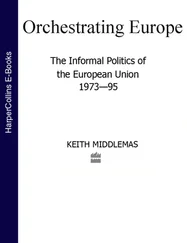C-o-n-g-r-a-t-u-l-a-t-i-o-n-s! As soon as you have more babies than you want, you might give me one. Must have a wife before you can have a baby. Rotten, I call it. I used to have to eat my bread and butter before I could have my cake. Same thing. I don’t think there is any just cause or impediment why you two should not be joined together in holy matrimony, but you might have let me know earlier. My God, if I’d heard the banns …! 10
Honeymooning in France, they sent him a ‘having-a-marvellous-time-hope-to-see-you-soon’ postcard. * 11
Unlike the free wild creatures of Jacques’ The Dancers , leaping Matisse-like on some ethereal shore, the figures of Stanley’s painting are contemplative, tremulous. Like Stanley himself, the figures stand on the threshold of a wild discovery and are amazed. *When the painting was later exhibited, Stanley was disconcerted to find its theme interpreted as a portrayal of sexual attraction. But to him this was neither its prime intent nor an aspect he wished emphasized. He wanted to ‘go past and beyond usual conceptions’. Why then, his critics argued, show the sexes separate? Again Stanley was baffled. He could ‘not account for the fact that I have divided the sexes in the picture.’ Of course he could not. If he showed them separate, that was because they were posed in the only way he could as yet manage; for in the sublimity to which he aspired he had as yet no experience of the sexual ‘fusion’ whose meaning he was struggling to understand. If his admirers could not grasp from his painting what he was trying to say, then there was little he could do to help them: ‘I feel rather like the young man who when he thinks his girl is admiring his thoughts and ideas and feelings finds that it is the way his hair curls which is the real attraction.’ 14
But to those like the Raverats who genuinely understood, Stanley’s joy in his painting was incontestable:
The picture was the first ambitious work, and I have in it wished to say what life was. … I felt a need for my religious experience expressed in earlier paintings to include all that was a happy experience for me. One can’t, I know, make endearing remarks to a canvas before you begin to paint on it, but I felt I could kiss the canvas all over just as I began to paint my apple picture on it. 15
CHAPTER FIVE
The Nativity
Study me then you who shall lovers be
At the next world, that is, at the next Spring,
For I am every dead thing
In whom Love wrought new Alchemy.
John Donne: Poems 1
ONCE POSSESSED of an overpowering idea, Stanley would all his life tenaciously worry its development through a succession of paintings. The desperate desire to resolve the paradox of duality became spiritual in Apple Gatherers. In The Nativity , also painted in 1912, the longing became religious.
If from the title we expect a conventional interpretation, we shall be surprised. Stanley is a will-o’-the-wisp who leads us unsuspectingly into what we think is familiar territory only, Puck-like, magically to change our surroundings, so that we stand bewildered, disturbed, abandoned, even resentful, according to our preconceptions.
What is it in his painting which so suddenly changes terrain we thought we knew? It is his composition , the transformation of content into visual presentation, which disorientates us, so that only slowly and perhaps incredulously do we begin to find our bearings. Many, in Stanley’s day, never found them, and simply relished the surprise. The message, to his chagrin, was all too often dismissed or devalued.
In his Nativity , the three Wise Men have come to visit. They are presented thus in a preliminary drawing. But now two of the Magi have become, surprisingly, the males of two pairs of lovers who meet as the emotional focus of the composition. The third remains a kneeling worshipper. The lovers are absorbed in each other and are oblivious to the presence of the Holy Family. This is not unexpected in view of the fact that Stanley intended the Holy Family to be not a tangible presence in Mill Lane, but visual imagery to convey his awed sense of sanctified discovery. Joseph, the figure on the right of the painting, is portrayed not in the manner of most traditional Nativities as the remarried widower of legend, an old man past sexual capability, but as a virile and romantic young man in a blue Botticelli robe, ‘doing something to a chestnut tree’. *
Despite this, the tree is in blossom, not fruit. The imagery is of the new life of spring; hardly relevant to a traditional Christmas scene. Precisely what Joseph is doing to the chestnut tree is left to conjecture, but his young thoughts are perhaps linked imaginatively to the erect chestnut candles with which it is girdled. Contrary to orthodox religious interpretations, it is suggested that he has every reason to be suffering sexual frustration. Mary, although a mother and his wife, is still a virgin. God has chosen her over Joseph’s head to become the link with the coming of creativity, a prodigious role in which he, Joseph – Stanley – has as yet no part.
Joseph is thus separated from Mary, who stands full in the centre of the painting, large, sombre-robed, almost masculine in appearance. Amy Hatch, another ‘cousin’ of Stanley’s, posed for her. She must, like Dorothy Wooster, have been a sturdy girl. ‘Monumental’ is Stanley’s own adjective for her in the painting, meaning that like a monument in a public place she is unnoticed by those who pass preoccupied. A miracle has been bestowed on her. Its physical form lies in the crib at her feet, added according to Stanley as ‘an afterthought’. For of course her concern in Stanley’s presentation is not so much with the child as with the wider meaning of creation, that which lies beyond the fence, the world where flesh-and-blood lovers meet in mutual delight. A separation – that of unfulfilment – exists between Mary and her spouse, and there is a division – the fence, the barrier of inaccessibility – between them as spiritual manifestations and the real world. Florence wrote:
neither is it strange that the grandchildren of a builder who was also a fine musician should have been consciously or subconsciously interested in the structural significance of walls and fugues. Cowls, walls and railings have from the first, I think, provided the fugue subjects of many of their works; the cowls, walls and railings which absently focussed our attention as children and about which as children our first thoughts and impressions played. 5
Like Mary in the painting, Stanley is gazing in wonder and longing at those who are about to enter a comprehension of the renewal of creation as experienced on earth. Indeed, the pairs of lovers may be drawn from Stanley’s feelings when Will or Harold or Florence married; the emotional amputation of departing siblings is a common enough experience in families. Rapt in the adoration of their beloveds, the Wise Men who came to see the birth of God have in that miracle become themselves part of the perennial birth of God, and advance to affirm the universal sacrament of life. Beyond them, in the background field, sheaves of corn seem stooked at harvest. Beyond again are the trees of Cliveden Woods, some of which seem to be turning into autumn brown. Perspective has become a series of compositional waves. Each wave is a season. A fourth dimension has been added to the canvas. Time itself has been compressed.
The secret of the painting stands revealed. It is a hymn to fecundity, to the compulsion and universality of the sexual instinct in its broadest concept, to that miraculousness of the process of creation which humanity has always seen as holy. Mary and Joseph are not simplistically the figures of accepted recognition, nor are the pairs of lovers those of poetic romance. The whole must be God. Mary and Joseph are primal figures dressed in Christian symbolism whose profoundest meanings go back beyond their own time, past the known gods of old, back to our earliest awareness of the sources of our existence and our survival.
Читать дальше









![Brian Thompson - A Monkey Among Crocodiles - The Life, Loves and Lawsuits of Mrs Georgina Weldon – a disastrous Victorian [Text only]](/books/704922/brian-thompson-a-monkey-among-crocodiles-the-life-thumb.webp)


